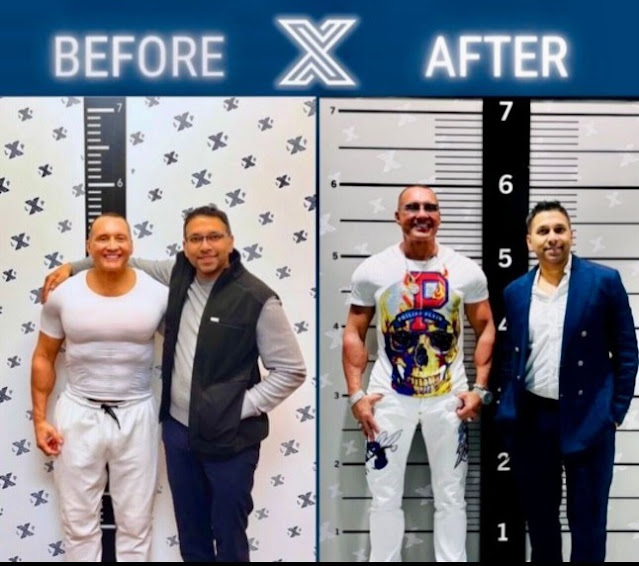Houston, Texas – Hugo, a Houston resident whose story of undergoing leg-lengthening surgery has captured public attention, has emerged from a challenging six-month recovery to embrace his new height of six feet. Speaking on the Just Between Us podcast, Hugo shared that the procedure, which defied medical advice and involved a risky yacht outing during recovery, has transformed his confidence and social interactions. “It took me being six foot to realize who I was,” he told hosts Allison Raskin and Gabe Dunn, recounting how a prominent Houston judge, who previously overlooked him, approached him to introduce herself after he reached his new height. Hugo also highlighted personal benefits, such as standing eye-to-eye with his 5’7” wife, who often wears six-inch heels. His story, marked by physical struggle and newfound self-assurance, sheds light on the growing popularity of leg-lengthening surgery, its medical complexities, and the societal dynamics of height in modern culture.
The Decision to Undergo Leg-Lengthening Surgery
Hugo’s journey began with a deeply personal decision to address his height, which he felt had held him back socially and professionally. Standing at five feet tall, Hugo, whose full name has not been disclosed for privacy reasons, described a sense of invisibility in social settings. “I’d walk into a room, and it was like I wasn’t there,” he said on the podcast. This sentiment, while personal, reflects a broader societal bias toward taller individuals, often associated with authority, competence, and attractiveness in Western culture.
Leg-lengthening surgery, a procedure that can increase a person’s height by several inches, is a complex and costly orthopedic intervention typically used for medical conditions like dwarfism or leg deformities. In recent years, however, it has gained traction among individuals seeking cosmetic enhancements, particularly men who feel disadvantaged by their height. The procedure involves surgically breaking the leg bones (usually the femur or tibia), inserting an internal or external lengthening device, and gradually extending the bones over weeks or months to stimulate new bone growth. The process is painful, expensive—often costing $70,000 to $150,000—and carries significant risks, including infection, nerve damage, and prolonged recovery.
Hugo’s decision to pursue the surgery was not made lightly. He consulted multiple orthopedic surgeons, weighing the physical and financial toll against the potential benefits. “I knew it was a big risk,” he admitted on the podcast. “But I also knew I wasn’t living the life I wanted.” His choice reflects a growing trend, particularly among men in their 20s and 30s, who view height as a key factor in personal and professional success. According to a 2024 study by the American Orthopedic Association, cosmetic leg-lengthening procedures have risen by 15% over the past decade, driven by advancements in surgical techniques and increased awareness through social media.
The Surgical Process and Recovery Challenges
The leg-lengthening process is grueling, requiring months of commitment and resilience. Hugo’s surgery, performed in Houston, likely involved the use of an internal telescopic rod, a common method in modern limb-lengthening procedures. The rod, inserted into the bone, is gradually extended using a remote-controlled magnetic system, lengthening the bone by approximately 1 millimeter per day. This slow, controlled process allows new bone tissue to form in the gap, but it demands strict adherence to medical protocols to avoid complications.
Hugo’s recovery, however, took an unconventional turn. By the third month post-surgery, he was battling boredom and frustration with the slow pace of healing. Against medical advice, he decided to board a yacht, a decision that risked destabilizing his healing bones. “I was going stir-crazy,” he explained. “I needed to feel alive again, even if it meant taking a chance.” The outing, while physically risky, did not result in catastrophic injury, though Hugo noted that he “felt the strain” in his legs afterward. For six months, he walked with a limp, relying on physical therapy and determination to rebuild his strength. “The muscles in my legs were weak at first, but as they got stronger, I started to feel myself balancing out,” he said.
Medical experts caution against such risks during recovery. Dr. Emily Chen, an orthopedic surgeon specializing in limb-lengthening at Houston Methodist Hospital, explained that premature weight-bearing or physical activity can lead to bone misalignment, delayed healing, or even permanent damage. “Patients are advised to follow a strict rehabilitation protocol, which includes limited mobility and regular physical therapy,” Dr. Chen said. “Ignoring these guidelines can jeopardize the entire procedure.” Hugo’s decision to defy medical advice underscores the psychological toll of the recovery process, which can be as challenging as the physical aspects.
By the six-month mark, Hugo’s perseverance paid off. His legs had healed, and he achieved his goal of standing at six feet tall—an increase of one foot from his original height. The transformation was not just physical but emotional, as Hugo described a newfound sense of self. “I walk into a room now, and I feel like I belong,” he said. His recovery, while unconventional, highlights the resilience required to navigate such a transformative procedure.
Social and Professional Impacts of Height
Hugo’s experience illustrates the profound social and professional implications of height, particularly in environments where first impressions matter. On the Just Between Us podcast, he shared a striking anecdote about a Houston judge who had never acknowledged him when he was five feet tall. “I’d been in the same circles as her for years, and she never looked my way,” he said. “But the first time I walked into a room at six foot, she came right over and introduced herself.” This encounter, while anecdotal, aligns with research on height bias. A 2019 study published in The Journal of Social Psychology found that taller individuals are often perceived as more competent and authoritative, influencing outcomes in professional and social settings.
The legal profession, where Hugo’s encounter with the judge took place, is particularly sensitive to such biases. Judges, attorneys, and other legal professionals often operate in high-stakes environments where confidence and presence are critical. Hugo’s newfound height gave him a psychological edge, allowing him to command attention in ways he hadn’t before. “It’s not just about the height,” he reflected. “It’s about how it changes the way you carry yourself and how others respond to you.”
This phenomenon extends beyond the courtroom. In corporate settings, studies have shown that taller individuals are more likely to secure leadership roles and higher salaries. A 2023 report by the Harvard Business Review noted that CEOs of Fortune 500 companies are, on average, 6’1” tall, significantly taller than the average American male height of 5’9”. While height alone does not determine success, it can amplify perceptions of competence, particularly in competitive fields.
Personal Benefits: A New Dynamic with His Wife
On a personal level, Hugo’s height transformation has reshaped his relationship with his wife, who stands at 5’7” and frequently wears six-inch heels, making her appear over six feet tall. “She was always taller than me,” Hugo said on the podcast, chuckling. “It used to bother me when we took pictures together—she’d be towering over me in those heels.” Now, at six feet, Hugo stands shoulder-to-shoulder with his wife, creating a more balanced dynamic in their public appearances. “It’s a small thing, but it makes a big difference,” he added. “We look like a team now.”
This change highlights the intersection of height and gender dynamics. In many cultures, traditional expectations place pressure on men to be taller than their female partners, a norm rooted in outdated notions of masculinity and femininity. Hugo’s candid admission that his wife’s height “used to bother” him reflects the internalized pressures many men face. His surgery, while driven by personal goals, also alleviated this discomfort, allowing him to feel more confident in their shared moments.
The couple’s dynamic also underscores the emotional benefits of cosmetic procedures. While leg-lengthening surgery is often criticized for reinforcing societal biases, for individuals like Hugo, it can provide a sense of empowerment and alignment with their self-image. “I’m not saying everyone should do this,” Hugo clarified. “But for me, it was about becoming the person I always felt I was inside.”
The Science and Ethics of Leg-Lengthening Surgery
Leg-lengthening surgery, pioneered in the 1950s by Soviet orthopedic surgeon Gavriil Ilizarov, has evolved significantly. Modern techniques, such as the PRECICE nail system, allow for precise, minimally invasive lengthening with reduced recovery times. The procedure typically involves three phases: surgery, lengthening, and consolidation. During the lengthening phase, patients use a remote control to extend the rod inside their bones, a process that can last 2–3 months. The consolidation phase, where new bone hardens, can take an additional 3–6 months, requiring intensive physical therapy to restore mobility.
Despite technological advances, the procedure remains controversial. Critics argue that cosmetic leg-lengthening reinforces harmful societal standards, particularly around height and appearance. “Heightism,” the bias favoring taller individuals, is a well-documented phenomenon, but surgeries like Hugo’s raise questions about whether individuals should conform to these standards or challenge them. Dr. Sarah Thompson, a medical ethicist at the University of Texas, argues that cosmetic procedures like leg-lengthening can perpetuate systemic biases. “When we alter our bodies to fit societal ideals, we risk reinforcing those ideals rather than questioning them,” she said.
On the other hand, proponents argue that such procedures empower individuals to take control of their self-image. “If someone feels their height is holding them back, and they’re willing to endure the pain and cost, who are we to judge?” said Dr. Michael Patel, an orthopedic surgeon who has performed dozens of leg-lengthening procedures. “It’s no different from other cosmetic surgeries, like rhinoplasty or breast augmentation.”
Hugo’s case also highlights the psychological dimensions of the procedure. Dr. Rachel Nguyen, a clinical psychologist specializing in body image, notes that height dissatisfaction is common among men, particularly in cultures that equate height with masculinity. “For some, addressing this through surgery can be life-changing, but it’s crucial to explore the underlying motivations,” she said. Hugo’s reflection—“It took me being six foot to realize who I was”—suggests that the surgery addressed not just his physical height but also deeper insecurities about his identity.
Societal Implications: Height, Status, and Perception
Hugo’s story is a microcosm of broader societal attitudes toward height. In the United States, where the average male height is 5’9” and the average female height is 5’4”, taller individuals often enjoy social advantages. Studies, such as one conducted by the University of Michigan in 2022, show that taller men are more likely to be promoted, elected to public office, or perceived as attractive in dating contexts. These biases, while subtle, can accumulate over a lifetime, influencing career trajectories and personal relationships.
For men like Hugo, who started at five feet, these dynamics are particularly pronounced. Short stature is often stigmatized, with terms like “short king” gaining traction on social media as a means of reclaiming pride but also acknowledging the underlying bias. Hugo’s decision to undergo surgery reflects a desire to transcend these limitations, but it also raises questions about the pressure to conform. “I didn’t do this for anyone else,” he insisted on the podcast. “I did it for me, to feel like I could take on the world.”
The gender dynamics of height are equally complex. Hugo’s wife, at 5’7” and often over six feet in heels, represents a growing number of women who defy traditional expectations of height in relationships. Her confidence in her stature contrasts with Hugo’s initial discomfort, highlighting how societal norms can affect men and women differently. The surgery’s impact on their relationship—allowing Hugo to feel “like a team” in photos—underscores the personal stakes of such decisions.
The Risks and Rewards of Defying Medical Advice
Hugo’s yacht outing during recovery, while successful in avoiding major injury, serves as a cautionary tale. Orthopedic surgeons emphasize that the lengthening process requires patience, as premature activity can lead to complications like bone fractures or device failure. Hugo’s limp, which persisted for six months, likely resulted from the strain of his yacht adventure, though his eventual recovery demonstrates the body’s resilience when supported by proper care.
Dr. Chen, the Houston-based surgeon, noted that patients often struggle with the psychological aspects of recovery. “You’re stuck in a wheelchair or on crutches for months, and it can feel isolating,” she said. “Some patients push their limits out of frustration, but it’s a gamble.” Hugo’s decision to take that gamble reflects the mental fortitude required to endure such a procedure, but it also underscores the need for better patient education and support.
The rewards, for Hugo, were worth the risks. His full recovery, achieved through physical therapy and muscle strengthening, allowed him to embrace his new height without long-term complications. “I have no regrets,” he said on the podcast. “It was tough, but I’d do it again in a heartbeat.”
The Role of Media and Public Perception
Hugo’s appearance on Just Between Us, a podcast known for its candid discussions of personal experiences, brought his story to a wider audience. Hosted by Allison Raskin and Gabe Dunn, the podcast has a loyal following, particularly among listeners interested in mental health, identity, and self-improvement. Hugo’s episode, which aired in August 2025, resonated with audiences, sparking conversations on platforms like X about height, body image, and the ethics of cosmetic surgery.
Posts on X ranged from supportive to critical. “Hugo’s story is inspiring—he took control of his life,” wrote @TexasTales, while @HeightMatters questioned, “Why do we keep pushing people to change their bodies instead of changing how we view height?” These reactions reflect the polarized nature of discussions about cosmetic procedures, with some viewing them as empowering and others as a capitulation to societal pressure.
Media coverage has amplified Hugo’s story, with outlets like Houston Chronicle and People magazine exploring the growing trend of leg-lengthening surgery. The coverage often frames Hugo as a relatable figure—a man who took a bold step to transform his life—but also raises ethical questions about the procedure’s accessibility. With costs exceeding $100,000 in many cases, leg-lengthening remains out of reach for most, raising concerns about class disparities in access to cosmetic enhancements.
The Future of Leg-Lengthening Surgery
As surgical techniques improve, leg-lengthening is likely to become more common, particularly in the United States, where cosmetic procedures are culturally normalized. Innovations like 3D-printed implants and robotic-assisted surgery could reduce risks and recovery times, making the procedure more appealing. However, the ethical debate will persist, as society grapples with the balance between personal autonomy and systemic biases.
For Hugo, the future is bright. Now fully recovered, he is embracing opportunities that his new height has unlocked, from professional networking to personal milestones. “I feel like I’m finally living my truth,” he said on the podcast. His story, while unique, reflects universal themes of self-discovery and resilience, resonating with anyone who has sought to redefine themselves in the face of societal expectations.
Conclusion
Hugo’s journey through leg-lengthening surgery is a testament to the power of personal transformation, but it also raises profound questions about height, identity, and societal norms. From risking injury on a yacht to standing tall beside his wife, Hugo’s experience encapsulates the physical and emotional complexities of altering one’s body to fit a desired self-image. His newfound confidence, evidenced by his interaction with a Houston judge and his improved dynamic with his wife, underscores the social advantages of height, but also the personal cost of achieving it.
As leg-lengthening surgery gains popularity, stories like Hugo’s will shape public perceptions of cosmetic procedures and their role in addressing insecurities. The procedure’s risks, costs, and ethical implications demand careful consideration, but for Hugo, the outcome was worth the struggle. “I’m not just taller,” he said. “I’m more myself than I’ve ever been.”
For those intrigued by Hugo’s story, the Just Between Us podcast episode offers a candid look at his journey, available on major streaming platforms. As the conversation around height and identity evolves, Hugo’s experience serves as both an inspiration and a point of reflection for a society navigating the intersection of personal choice and cultural expectations.







